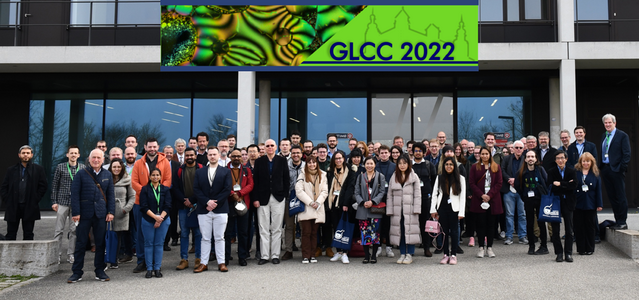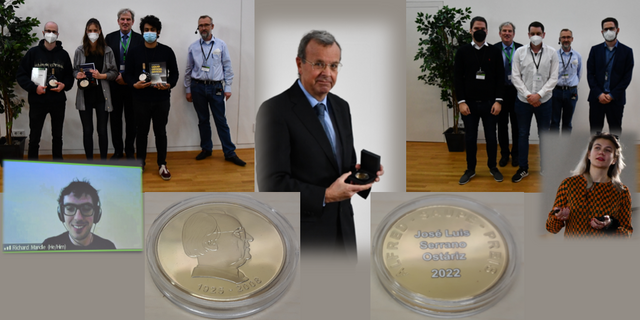Conference Report, Awards and GLCC2022 Photos
First On-Site Conference at the University of Würzburg with 80 European Researchers at the 48th German Liquid Crystal Conference GLCC2022

Photograph: Lisa Gerbig
„Eventually a conference with face to face contact of the participants”, that was the prevailing mood to which around 80 Liquid Crystal researchers gathered from the 28th to 30th of March 2022 at the University of Würzburg. The participants were invited by the German Liquid Crystal Society DFKG and the organiser team around Prof. Dr. Matthias Lehmann (University of Würzburg) and Prof. Dr. Heiner Detert (University of Mainz) and welcomed by the vice president for innovation and knowledge transfer Prof. Dr. Matthias Bode. This meeting was unique from two perspectives: First it was the first on-site event after the pandemic at the University of Würzburg and second for the first time researchers from all over Europe gathered at this national conference.
Liquid crystals in everyday life and in nature
The topic of the conference were the multidisciplinary area of „Liquid Crystals“, which were discovered 134 years ago by Friedrich Reinitzer (Prag) und Otto Lehmann (Karlsruhe) and which started 80 years later its triumphant progress in the display technology (LCDs). Today these materials can be encountered in LCD televisions, notebooks, PC flat panel displays, smartphones, but also in liquid soaps, which can be found in almost all households. The combination of fluid (liquids) and anisotropic (crystal) properties in the so-called fourth state of matter, the liquid crystal, is of outmost importance also in nature, for example for the spinning process of spider silk, the cell double walls or the cell division (mitosis). Also during the production of high-tensile strength and light-weight polymers, such as Kevlar® or Vectra®, which are applied for bullet-proofed jackets or high-performance ropes for climbing, the liquid-crystalline state of matter plays a pivotal role.
Platform for young scientists
The event was primarily carried out by the young scientists, who presented their newest scientific progress from a number of different laboratories. 21 oral contributions, 13 poster-appetizer and 41 posters documented the multidisciplinary activities. Seven European young scientists were awarded for their excellent performance with four DFKG Young Investigator Awards and three book prices; DFKG Young Investigator Awardees: Paulina Rybak (University of Warsaw, Poland), Pierre Nacke (University of Stuttgart), Christopher Schilling (University of Stuttgart), Tobias Thiele (University of Duisburg-Essen); Book prices: Charlotte Vogler (University of Stuttgart), Kevin Mall Haidaraly (Sorbonne University Paris, France), Michael Gölz (Technical University Darmstadt).
| Alfred Saupe Prize, Vorländer Lecture ceremony and the Young Investigator Prizes: Left top: Book prizes (from left) Michael Gölz (Darmstadt), Charlotte Vogler (Stuttgart), Prof. Dr. Matthias Lehmann (Würzburg, conference chair), Kevin Mall Haidaraly (Paris) and Prof. Dr. Heiner Detert (Mainz, cochair). Left bottom: Dr. Richard Mandle (Leeds, Vorländer Lecture Laureate). Middle: Prof. Dr. José Luis Serrano Ostáriz (Zaragoza, Saupe Prize Laureate) with the Alfred Saupe Medal. Right: Young Investigator Prize of the DFKG for (from left) Pierre Nacke (Stuttgart), Tobias Thiele (Duisburg-Essen), Christoph Schilling (Stuttgart) and right bottom Paulina Rybak (Warsaw). Photograph: Lisa Gerbig and Matthias Lehmann. |
Scientific and Cultural Highlights
At this extremely successful event, the Spanish researcher Professor José Luis Serrano Ostáriz was awarded the highest prize of the German Liquid Crystals Society and the Alfred Saupe foundation for his lifetime achievements – the Alfred Saupe Prize 2022. The Vorländer lecture, with which young, successful researchers are honoured at the beginning of their career, was assigned to the British shooting-star Dr. Richard Mandle (University of Leeds). He is one of the discoverer of the ferroelectric nematic phase, for which a high application potential is predicted. The organization of the meeting was possible not without the numerous sponsors such as Synthon Chemicals, Merck and Bruker.
Thus the national and international participants from Italy, Germany, England, Poland, The Netherlands, Luxembourg, Spain, Portugal, Poland, France and India could also experience the exciting cultural impressions of Würzburg and the culinary pleasured of the Franconian region at the conference dinner in the residence and the wine tasting in the freshly renovated state court cellar (Staatlicher Hofkeller). The participants enjoyed the conference in Würzburg and certainly intent to visit the region again in the future for scientific but also for touristic reasons.
A PDF-file with some photographs is provided below in order to get some impressions of the conference. Participants may download the PDF by using the same password as for the Book of Abstracts. The Images will be online until the end of April. In urgent need of better photograph quality you may write to the conference organisers (glcc2022@uni-wuerzburg.de).
Thank you all for your participation and we hope you enjoyed the first on-side conference after two years in Würzburg!






